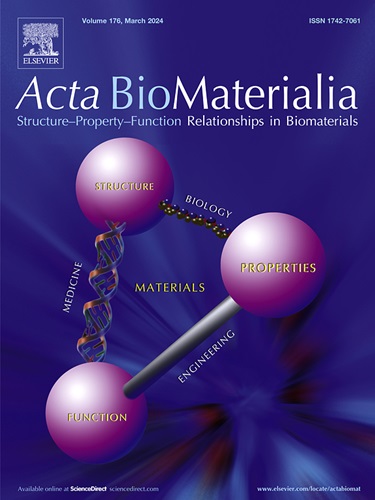Biodegradable Zn-Li-Mn alloy to achieve optimal strength and ductility for bone implants
IF 9.4
1区 医学
Q1 ENGINEERING, BIOMEDICAL
引用次数: 0
Abstract
Biodegradable zinc-based metals have received attention due to their strength, biodegradability, and desirable biocompatibility. However, the trade-off between strength and ductility has limited their use. Here, we designed a biodegradable Zn-Li-Mn ternary alloy with superior strength and ductility. The ultimate tensile strength (UTS) of Zn-0.4Li-xMn (x = 0.1, 0.4, and 0.8) alloys reached 438.74–469.96 MPa, similar to pure Ti, with elongation reaching 41.52%–54.91%, surpassing other Zn-Li-based alloys. We investigated the biodegradation behavior and osteogenic effects of the Zn-Li-Mn alloys both in vitro and in vivo. Immersion tests demonstrated that the alloys exhibited a more uniform degradation morphology with significantly less release of Zn2+ ion compared to pure Zn. Cytocompatibility, hemocompatibility, and histological analyses demonstrated their biosafety. In addition, Zn-Li-Mn alloy extracts significantly enhanced osteogenesis of human bone marrow-derived mesenchymal stem cells (hBMSCs), manifesting higher alkaline phosphatase activity, increased biomineralization, and elevated osteogenic gene expression. Zn-0.4Li-0.8Mn alloy showed the highest osteogenic activity in vitro. When implanted in rat femoral condyles, it demonstrated improved in vivo bone regeneration effects, exhibiting enhanced osteointegration. Transcriptomic analysis revealed that Zn2+, Mn2+, and Li+ ions released from Zn-Li-Mn alloy collectively activated the MAPK-ERK and Wnt/β-catenin signaling pathways, prompting osteogenic differentiation. These findings demonstrate the high potential of the Zn-0.4Li-0.8Mn alloy for bone implants.
Statement of Significance
1. Biodegradable Zn-Li-Mn ternary alloy with superior mechanical strength and excellent ductility were designed. 2. Enhanced osteointegration were observed in Zn-0.4Li-0.8Mn implants in vivo. 3. Transcriptomic analysis revealed that the Zn2+, Mn2+, and Li+ released from Zn-0.4Li-0.8Mn collectively activated the MAPK-ERK and Wnt/β-catenin signaling pathways, enhancing osteogenesis.
生物可降解的锌-锂-锰合金,为骨植入物提供最佳的强度和延展性。
生物可降解锌基金属因其强度、生物可降解性和良好的生物相容性而受到人们的关注。然而,强度和延性之间的权衡限制了它们的使用。在这里,我们设计了一种具有优异强度和延展性的可生物降解的Zn-Li-Mn三元合金。Zn-0.4Li-xMn (x = 0.1、0.4和0.8)合金的极限抗拉强度(UTS)达到438.74 ~ 469.96 MPa,与纯Ti相近,伸长率达到41.52% ~ 54.91%,优于其他zn - li基合金。研究了Zn-Li-Mn合金在体内和体外的生物降解行为和成骨作用。浸泡试验表明,与纯Zn相比,合金的降解形貌更加均匀,Zn2+离子的释放明显减少。细胞相容性、血液相容性和组织学分析证明了它们的生物安全性。此外,Zn-Li-Mn合金提取物显著促进人骨髓间充质干细胞(hBMSCs)的成骨,表现出更高的碱性磷酸酶活性,增加生物矿化,提高成骨基因表达。Zn-0.4Li-0.8Mn合金体外成骨活性最高。植入大鼠股骨髁后,其体内骨再生效果明显改善,骨整合能力增强。转录组学分析显示,Zn-Li-Mn合金释放的Zn2+、Mn2+和Li+离子共同激活了MAPK-ERK和Wnt/β-catenin信号通路,促进了成骨分化。这些研究结果表明,Zn-0.4Li-0.8Mn合金作为骨种植体具有很高的潜力。意义陈述:1;设计了具有优异机械强度和延展性的生物可降解锌锂锰三元合金。2. 体内观察到Zn-0.4Li-0.8Mn种植体骨整合增强。3. 转录组学分析显示,Zn-0.4Li-0.8Mn释放的Zn2+、Mn2+和Li+共同激活了MAPK-ERK和Wnt/β-catenin信号通路,促进了成骨。
本文章由计算机程序翻译,如有差异,请以英文原文为准。
求助全文
约1分钟内获得全文
求助全文
来源期刊

Acta Biomaterialia
工程技术-材料科学:生物材料
CiteScore
16.80
自引率
3.10%
发文量
776
审稿时长
30 days
期刊介绍:
Acta Biomaterialia is a monthly peer-reviewed scientific journal published by Elsevier. The journal was established in January 2005. The editor-in-chief is W.R. Wagner (University of Pittsburgh). The journal covers research in biomaterials science, including the interrelationship of biomaterial structure and function from macroscale to nanoscale. Topical coverage includes biomedical and biocompatible materials.
 求助内容:
求助内容: 应助结果提醒方式:
应助结果提醒方式:


